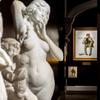A Light in Darkness: Masterful Nocturne Paintings
- July 03, 2013 14:28
When we think about the role that light plays in painting, we most often consider the changing day-lit palettes of works by Claude Monet and other masters of the French Impressionist movement. However, a number of artists were enchanted by the unique nature that light takes on under the haze of darkness. These paintings of night-time scenes, or nocturnes, when created by masters such as John Atkinson Grimshaw and Petrus van Schendel, captured the otherworldly beauty and distinct intimacy of their subjects at the edge of light and dark.
The term “nocturne” was coined by the great James McNeill Whistler, who, besides painting his mother, created provocative works such as Nocturne in Black and Gold: The Falling Rocket, a depiction of fireworks that gave him the starring role in the most sensational libel trial of the 19th century. The term is musical in origin, and refers to the dreamy atmosphere or pensive mood that many of these paintings conveyed.
Though the name was coined during the Belle Epoque, night scenes have been painted as far back as the 14th century, when artists such as Giotto and Bosch placed both religious and secular scenes against the backdrop of evening. Rembrandt and Peter Paul Rubens painted dramatic, lantern-lit Biblical scenes enveloped in darkness in the 17th century, and in the early 19th century, Romantics like Francisco Goya and Eugène Delacroix portrayed highly charged current events beneath dark, stormy skies and glaring spotlights. And of course, who can forget Vincent van Gogh’s Starry Night? The sense of drama and atmosphere captured in these paintings was not, then, due to the lack of light, but by its very real presence in the form of candle and lamplight, starlight and moonlight. By the end of the 19th century, two artists were the masters of capturing the particular illumination from these differing sources: John Atkinson Grimshaw and Petrus van Schendel.
Whistler once said of his friend Grimshaw, “I considered myself the inventor of nocturnes until I saw Grimmy’s moonlight pictures.” Truly, his was an outstanding talent, as shown in his remarkable work, The Bend of the Road. In this important piece, Grimshaw paints a country scene at twilight, and the effects of two different sources of light, the moon and dimly-lit windows, lend the highly-detailed scene a poetic beauty.
Dutch Romantic painter Petrus van Schendel employed the medium of candlelight to its fullest effect, which earned him the nickname “Monsieur Chandelle.” Considered by many to be the master of light and atmosphere, van Schendel created night-time market scenes, such as 1865’s An Evening Market, that glow with warmth and familiarity. Van Schendel’s uncanny understanding of light and shadow greatly enhances the realism of the scene.
Nocturnes are among my favorite pieces of artwork. If you find them as captivating as I do, you will soon discover that their variety and poetry will fascinate you for a lifetime.






100x100_n.jpg)
100x100_c.jpg)













100x100_c.jpg)